roof rack FIAT BRAVO 2013 2.G Owners Manual
[x] Cancel search | Manufacturer: FIAT, Model Year: 2013, Model line: BRAVO, Model: FIAT BRAVO 2013 2.GPages: 299, PDF Size: 5.86 MB
Page 2 of 299
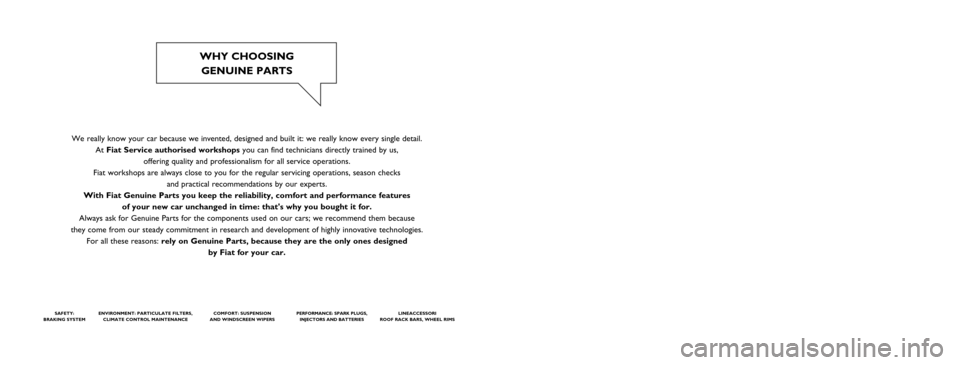
We really know your car because we invented, designed and built it: we really know every single detail.
At Fiat Service authorised workshopsyou can find technicians directly trained by us,
offering quality and professionalism for all service operations.
Fiat workshops are always close to you for the regular servicing operations, season checks
and practical recommendations by our experts.
With Fiat Genuine Parts you keep the reliability, comfort and performance features
of your new car unchanged in time: that's why you bought it for.
Always ask for Genuine Parts for the components used on our cars; we recommend them because
they come from our steady commitment in research and development of highly innovative technologies.
For all these reasons: rely on Genuine Parts, because they are the only ones designed
by Fiat for your car.
SAFETY:
BRAKING SYSTEMENVIRONMENT: PARTICULATE FILTERS,
CLIMATE CONTROL MAINTENANCECOMFORT: SUSPENSION
AND WINDSCREEN WIPERS PERFORMANCE: SPARK PLUGS,
INJECTORS AND BATTERIESLINEACCESSORI
ROOF RACK BARS, WHEEL RIMS
WHY CHOOSING
GENUINE PARTS
BRAVO LUM GB:BRAVO UM GB 24-05-2012 14:30 Pagina 2
Page 95 of 299
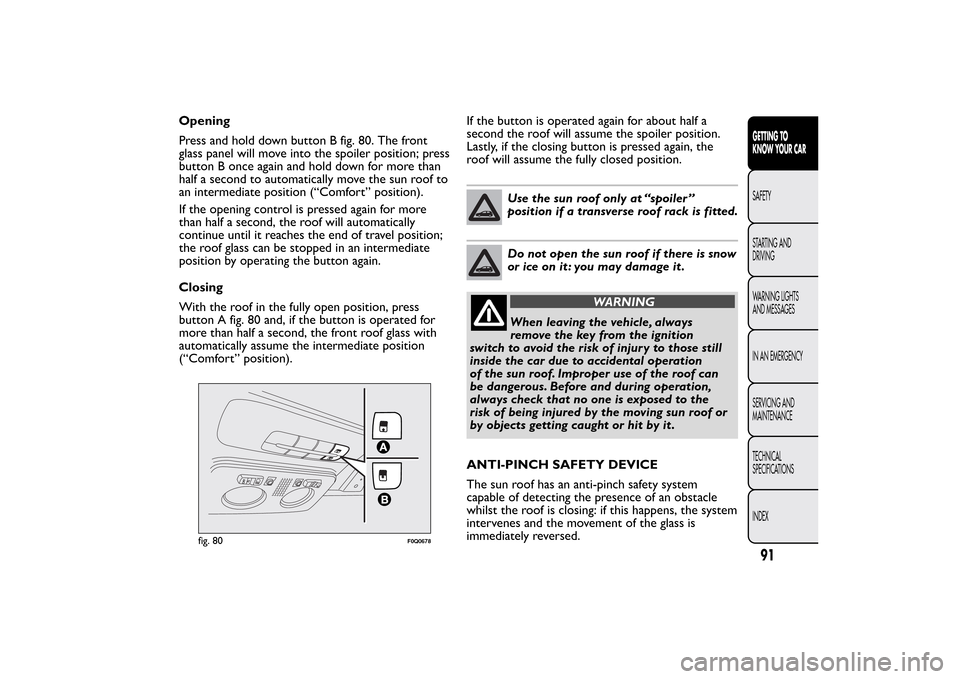
Opening
Press and hold down button B fig. 80. The front
glass panel will move into the spoiler position; press
button B once again and hold down for more than
half a second to automatically move the sun roof to
an intermediate position (“Comfort” position).
If the opening control is pressed again for more
than half a second, the roof will automatically
continue until it reaches the end of travel position;
the roof glass can be stopped in an intermediate
position by operating the button again.
Closing
With the roof in the fully open position, press
button A fig. 80 and, if the button is operated for
more than half a second, the front roof glass with
automatically assume the intermediate position
(“Comfort” position).If the button is operated again for about half a
second the roof will assume the spoiler position.
Lastly, if the closing button is pressed again, the
roof will assume the fully closed position.
Use the sun roof only at “spoiler ”
position if a transverse roof rack is fitted.Do not open the sun roof if there is snow
or ice on it : you may damage it .
WARNING
When leaving the vehicle, always
remove the key from the ignition
switch to avoid the risk of injur y to those still
inside the car due to accidental operation
of the sun roof. Improper use of the roof can
be dangerous. Before and during operation,
always check that no one is exposed to the
risk of being injured by the moving sun roof or
by objects getting caught or hit by it .
ANTI-PINCH SAFETY DEVICE
The sun roof has an anti-pinch safety system
capable of detecting the presence of an obstacle
whilst the roof is closing: if this happens, the system
intervenes and the movement of the glass is
immediately reversed.
fig. 80
F0Q0678
91GETTING TO
KNOW YOUR CARSAFETY
STARTING AND
DRIVING
WARNING LIGHTS
AND MESSAGES
IN AN EMERGENCY
SERVICING AND
MAINTENANCE
TECHNICAL
SPECIFICATIONS
INDEX
Page 108 of 299
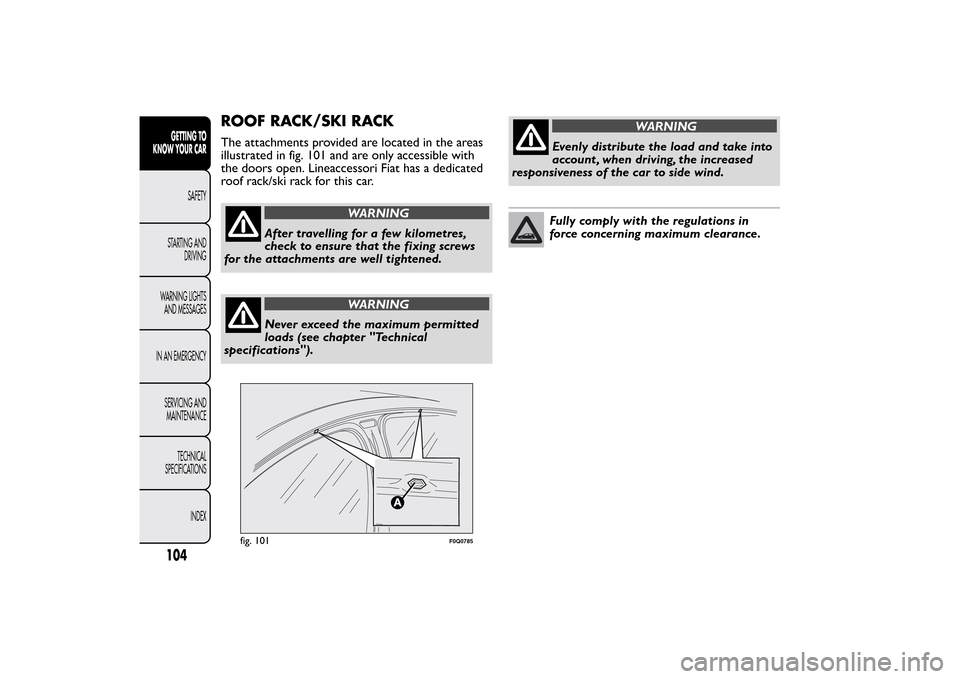
ROOF RACK/SKI RACKThe attachments provided are located in the areas
illustrated in fig. 101 and are only accessible with
the doors open. Lineaccessori Fiat has a dedicated
roof rack/ski rack for this car.
WARNING
After travelling for a few kilometres,
check to ensure that the fixing screws
for the attachments are well tightened.
WARNING
Never exceed the maximum permitted
loads (see chapter "Technical
specifications").
WARNING
Evenly distribute the load and take into
account , when driving, the increased
responsiveness of the car to side wind.Fully comply with the regulations in
force concerning maximum clearance.
fig. 101
F0Q0785
104GETTING TO
KNOW YOUR CAR
SAFETY
STARTING AND
DRIVING
WARNING LIGHTS
AND MESSAGES
IN AN EMERGENCY
SERVICING AND
MAINTENANCE
TECHNICAL
SPECIFICATIONS
INDEX
Page 163 of 299
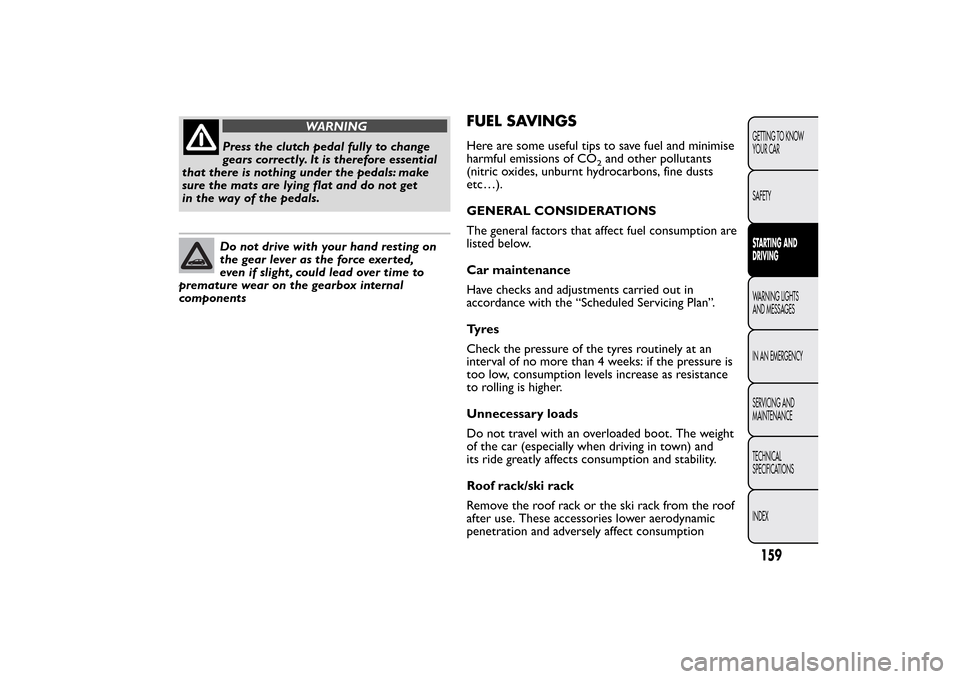
WARNING
Press the clutch pedal fully to change
gears correctly. It is therefore essential
that there is nothing under the pedals: make
sure the mats are lying flat and do not get
in the way of the pedals.Do not drive with your hand resting on
the gear lever as the force exerted,
even if slight , could lead over time to
premature wear on the gearbox internal
components
FUEL SAVINGSHere are some useful tips to save fuel and minimise
harmful emissions of CO
2and other pollutants
(nitric oxides, unburnt hydrocarbons, fine dusts
etc…).
GENERAL CONSIDERATIONS
The general factors that affect fuel consumption are
listed below.
Car maintenance
Have checks and adjustments carried out in
accordance with the “Scheduled Servicing Plan”.
Ty r e s
Check the pressure of the tyres routinely at an
interval of no more than 4 weeks: if the pressure is
too low, consumption levels increase as resistance
to rolling is higher.
Unnecessary loads
Do not travel with an overloaded boot. The weight
of the car (especially when driving in town) and
its ride greatly affects consumption and stability.
Roof rack/ski rack
Remove the roof rack or the ski rack from the roof
after use. These accessories lower aerodynamic
penetration and adversely affect consumption
159GETTING TO KNOW
YOUR CAR
SAFETYSTARTING AND
DRIVINGWARNING LIGHTS
AND MESSAGES
IN AN EMERGENCY
SERVICING AND
MAINTENANCE
TECHNICAL
SPECIFICATIONS
INDEX
Page 275 of 299
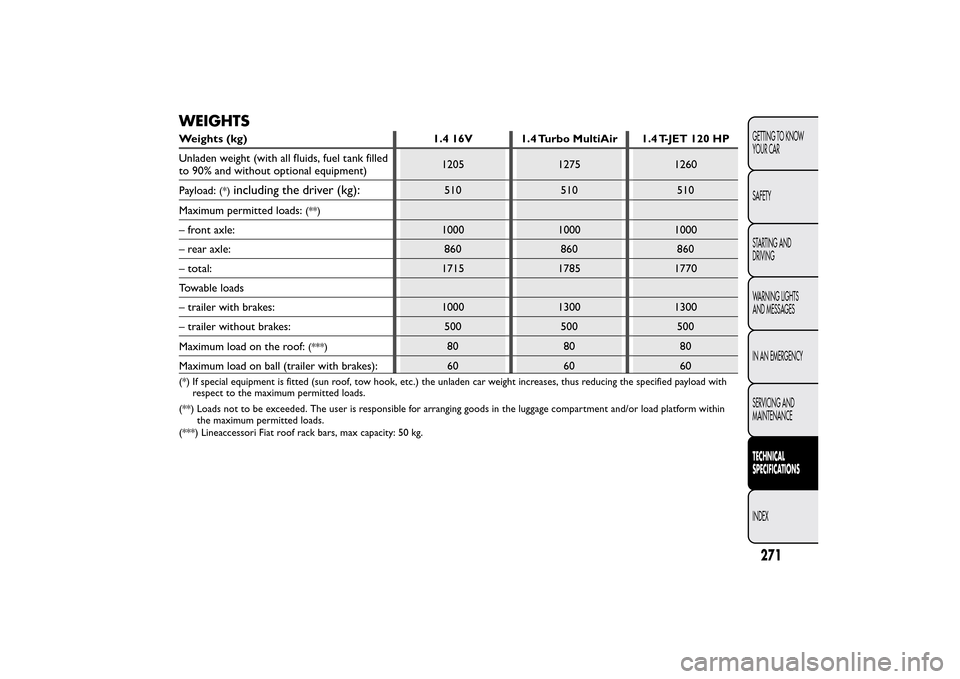
WEIGHTSWeights (kg) 1.4 16V 1.4 Turbo MultiAir 1.4 T-JET 120 HP
Unladen weight (with all fluids, fuel tank filled
to 90% and without optional equipment)1205 1275 1260
Payload:
(*)
including the driver (kg):
510 510 510
Maximum permitted loads:
(**)
– front axle: 1000 1000 1000
– rear axle: 860 860 860
– total: 1715 1785 1770
Towable loads
– trailer with brakes: 1000 1300 1300
– trailer without brakes: 500 500 500
Maximum load on the roof:
(***)
80 80 80
Maximum load on ball (trailer with brakes): 60 60 60
(*) If special equipment is fitted (sun roof, tow hook, etc.) the unladen car weight increases, thus reducing the specified payload with
respect to the maximum permitted loads.
(**) Loads not to be exceeded. The user is responsible for arranging goods in the luggage compartment and/or load platform within
the maximum permitted loads.
(***) Lineaccessori Fiat roof rack bars, max capacity: 50 kg.
271GETTING TO KNOW
YOUR CAR
SAFETY
STARTING AND
DRIVING
WARNING LIGHTS
AND MESSAGES
IN AN EMERGENCY
SERVICING AND
MAINTENANCETECHNICAL
SPECIFICATIONSINDEX
Page 276 of 299
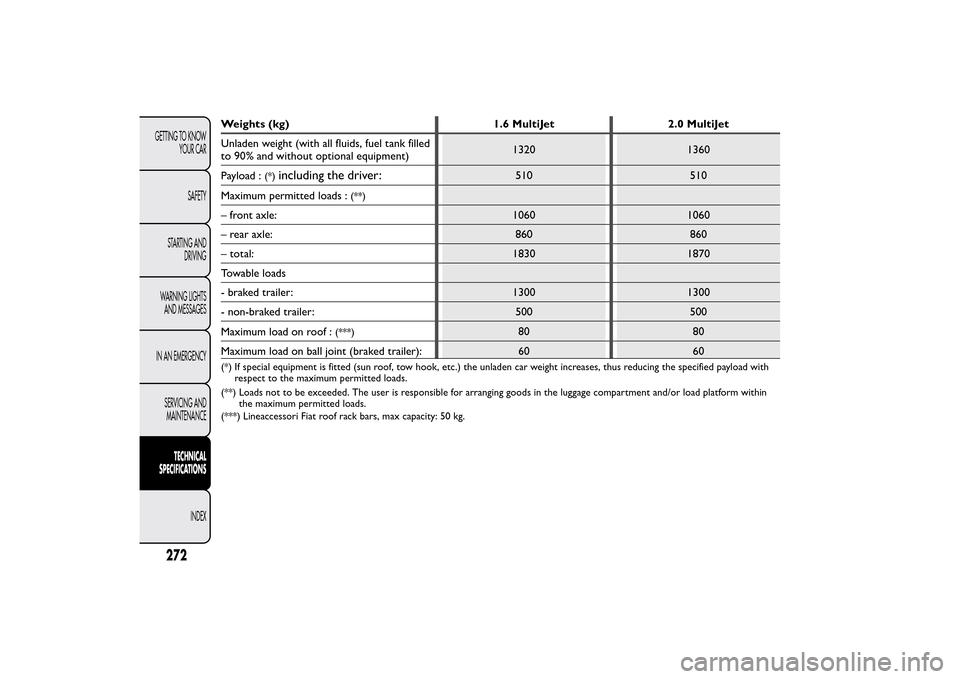
Weights (kg) 1.6 MultiJet 2.0 MultiJet
Unladen weight (with all fluids, fuel tank filled
to 90% and without optional equipment)1320 1360
Payload :
(*)
including the driver:
510 510
Maximum permitted loads :
(**)
– front axle: 1060 1060
– rear axle: 860 860
– total: 1830 1870
Towable loads
- braked trailer: 1300 1300
- non-braked trailer: 500 500
Maximum load on roof :
(***)
80 80
Maximum load on ball joint (braked trailer): 60 60
(*) If special equipment is fitted (sun roof, tow hook, etc.) the unladen car weight increases, thus reducing the specified payload with
respect to the maximum permitted loads.
(**) Loads not to be exceeded. The user is responsible for arranging goods in the luggage compartment and/or load platform within
the maximum permitted loads.
(***) Lineaccessori Fiat roof rack bars, max capacity: 50 kg.
272GETTING TO KNOW
YOUR CAR
SAFETY
STARTING AND
DRIVING
WARNING LIGHTS
AND MESSAGES
IN AN EMERGENCY
SERVICING AND
MAINTENANCE
TECHNICAL
SPECIFICATIONS
INDEX
Page 282 of 299
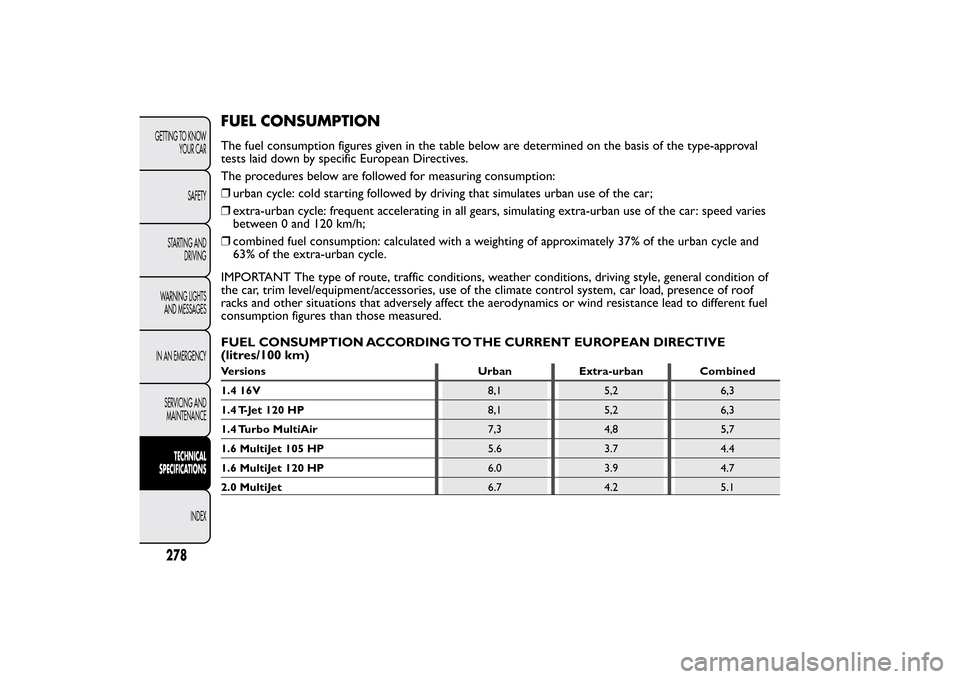
FUEL CONSUMPTIONThe fuel consumption figures given in the table below are determined on the basis of the type-approval tests laid down by specific European Directives. The procedures below are followed for measuring consumption:❒
urban cycle: cold starting followed by driving that simulates urban use of the car;
❒
extra-urban cycle: frequent accelerating in all gears, simulating extra-urban use of the car: speed varies between 0 and 120 km/h;
❒
combined fuel consumption: calculated with a weighting of approximately 37% of the urban cycle and 63% of the extra-urban cycle.
IMPORTANT The type of route, traffic conditions, weather conditions, driving style, general condition of the car, trim level/equipment/accessories, use of the climate control system, car load, presence of roofracks and other situations that adversely affect the aerodynamics or wind resistance lead to different fuelconsumption figures than those measured. FUEL CONSUMPTION ACCORDING TO THE CURRENT EUROPEAN DIRECTIVE (litres/100 km)Versions Urban Extra-urban Combined 1.4 16V
8,1 5,2 6,3
1.4 T-Jet 120 HP
8,1 5,2 6,3
1.4 Turbo MultiAir
7,3
4,8
,7
1.6 MultiJet 105 HP
5.6 3.7 4.4
1.6 MultiJet 120 HP
6.0 3.9 4.7
2.0 MultiJet
6.7 4.2 5.1
278GETTING TO KNOW
YOUR CAR SAFETY
STARTING AND
DRIVING
WARNING LIGHTS AND MESSAGES IN AN EMERGENCY SERVICING AND MAINTENANCETECHNICAL
SPECIFICATIONS
INDEX
5
Page 296 of 299
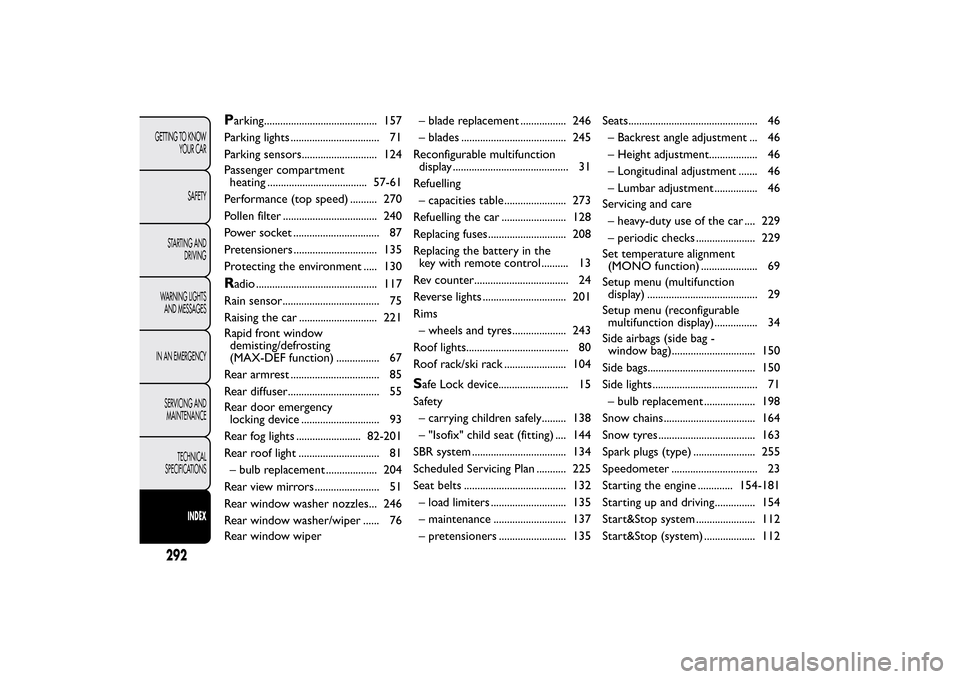
Parking.......................................... 157
Parking lights ................................. 71
Parking sensors............................ 124
Passenger compartment
heating ..................................... 57-61
Performance (top speed) .......... 270
Pollen filter ................................... 240
Power socket ................................ 87
Pretensioners ............................... 135
Protecting the environment ..... 130Radio ............................................. 117
Rain sensor.................................... 75
Raising the car ............................. 221
Rapid front window
demisting/defrosting
(MAX-DEF function) ................ 67
Rear armrest ................................. 85
Rear diffuser.................................. 55
Rear door emergency
locking device ............................. 93
Rear fog lights ........................ 82-201
Rear roof light .............................. 81
– bulb replacement ................... 204
Rear view mirrors ........................ 51
Rear window washer nozzles... 246
Rear window washer/wiper ...... 76
Rear window wiper– blade replacement ................. 246
– blades ....................................... 245
Reconfigurable multifunction
display ........................................... 31
Refuelling
– capacities table ....................... 273
Refuelling the car ........................ 128
Replacing fuses............................. 208
Replacing the battery in the
key with remote control .......... 13
Rev counter................................... 24
Reverse lights ............................... 201
Rims
– wheels and tyres.................... 243
Roof lights...................................... 80
Roof rack/ski rack ....................... 104
Safe Lock device.......................... 15
Safety
– carrying children safely......... 138
– "Isofix" child seat (fitting) .... 144
SBR system ................................... 134
Scheduled Servicing Plan ........... 225
Seat belts ...................................... 132
– load limiters ............................ 135
– maintenance ........................... 137
– pretensioners ......................... 135Seats................................................ 46
– Backrest angle adjustment ... 46
– Height adjustment.................. 46
– Longitudinal adjustment ....... 46
– Lumbar adjustment ................ 46
Servicing and care
– heavy-duty use of the car .... 229
– periodic checks ...................... 229
Set temperature alignment
(MONO function) ..................... 69
Setup menu (multifunction
display) ......................................... 29
Setup menu (reconfigurable
multifunction display)................ 34
Side airbags (side bag -
window bag)............................... 150
Side bags........................................ 150
Side lights....................................... 71
– bulb replacement ................... 198
Snow chains.................................. 164
Snow tyres .................................... 163
Spark plugs (type) ....................... 255
Speedometer ................................ 23
Starting the engine ............. 154-181
Starting up and driving............... 154
Start&Stop system ...................... 112
Start&Stop (system) ................... 112
292GETTING TO KNOW
YOUR CAR
SAFETY
STARTING AND
DRIVING
WARNING LIGHTS
AND MESSAGES
IN AN EMERGENCY
SERVICING AND
MAINTENANCE
TECHNICAL
SPECIFICATIONS
INDEX